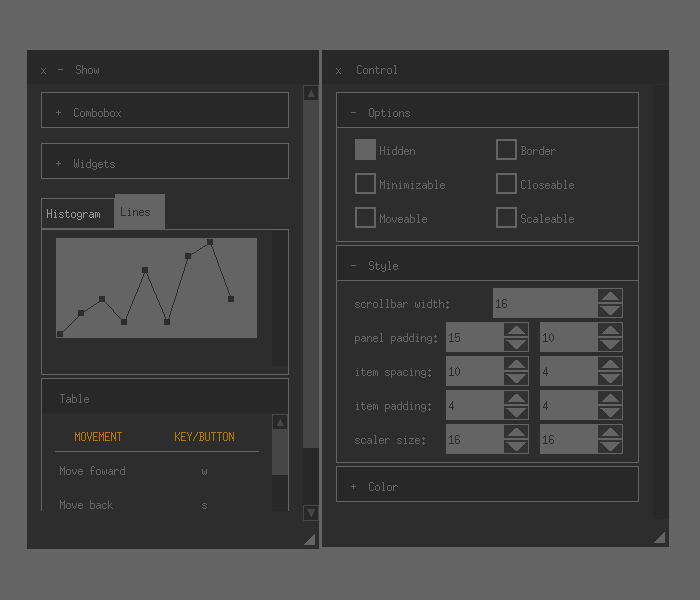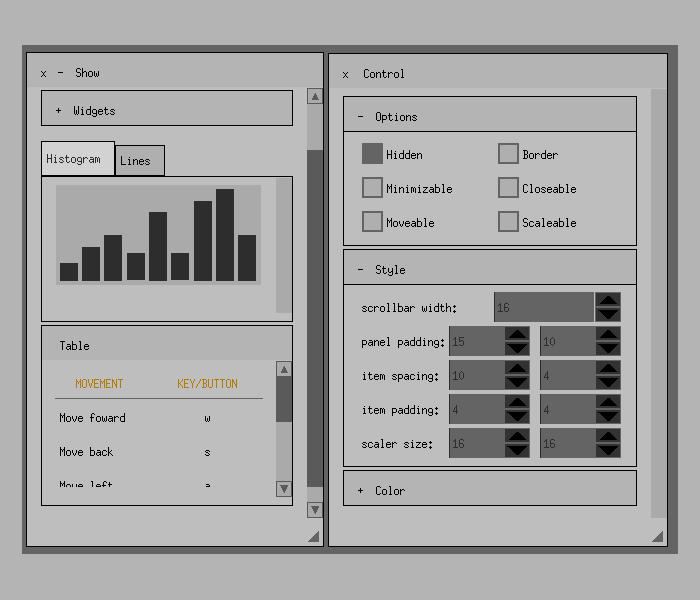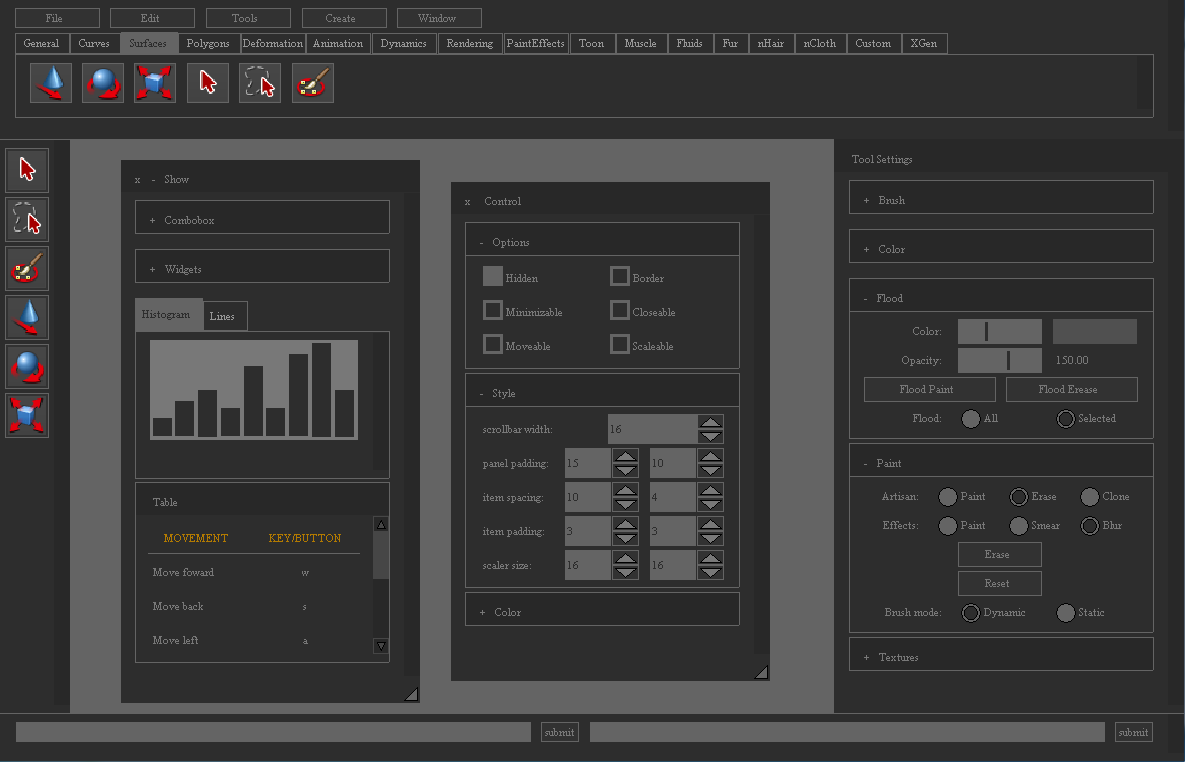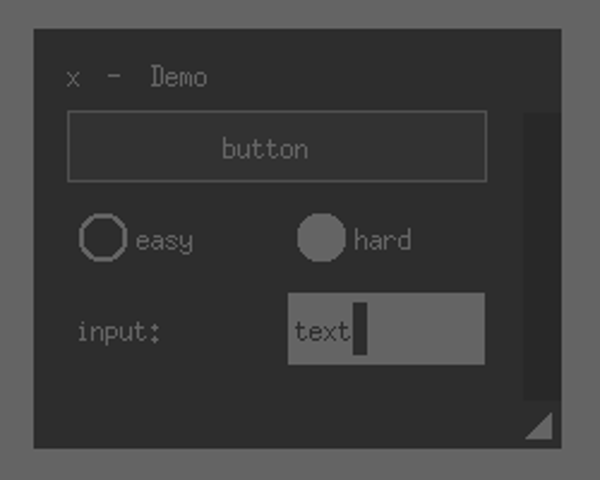21 KiB
GUI
This is a bloat free minimal state immediate mode graphical user interface toolkit written in ANSI C. It was designed as a embeddable user interface for graphical application and does not have any direct dependencies.
Features
- Immediate mode graphical user interface toolkit
- Written in C89 (ANSI C)
- Small codebase (~3kLOC)
- Focus on portability, efficiency, simplicity and minimal internal state
- Suited for embedding into graphical applications
- No global or hidden state
- No direct dependencies (not even libc!)
- Full memory management control
- Renderer and platform independent
- Configurable style and colors
- UTF-8 support
Limitations
- Does NOT provide os window/input management
- Does NOT provide a renderer backend
- Does NOT implement a font library
Summary: It is only responsible for the actual user interface
Target applications
- Graphical tools/editors
- Library testbeds
- Game engine debugging UI
- Graphical overlay
Gallery
Example
/* allocate memory to hold output */
struct gui_memory memory = {...};
struct gui_command_buffer buffer;
gui_buffer_init_fixed(buffer, &memory, 0);
/* initialize panel */
struct gui_config config;
struct gui_input input = {0};
struct gui_font font = {...};
struct gui_panel panel;
gui_config_default(&config);
gui_panel_init(&panel, 50, 50, 220, 170,
GUI_PANEL_BORDER|GUI_PANEL_MOVEABLE|
GUI_PANEL_CLOSEABLE|GUI_PANEL_SCALEABLE|
GUI_PANEL_MINIMIZABLE, &config, &font);
while (1) {
gui_input_begin(&input);
/* record input */
gui_input_end(&input);
/* transient frame data */
struct gui_canvas canvas;
struct gui_command_list list;
struct gui_panel_layout layout;
struct gui_memory_status status;
/* GUI */
gui_buffer_begin(&canvas, &buffer, window_width, window_height);
gui_panel_begin(&layout, &panel, "Demo", &canvas, &input);
gui_panel_row(&layout, 30, 1);
if (gui_panel_button_text(&layout, "button", GUI_BUTTON_DEFAULT)) {
/* event handling */
}
gui_panel_row(&layout, 30, 2);
if (gui_panel_option(&layout, "easy", option == 0)) option = 0;
if (gui_panel_option(&layout, "hard", option == 1)) option = 1;
gui_panel_label(&layout, "input:", GUI_TEXT_LEFT);
len = gui_panel_edit(&layout, buffer, len, 256, &active, GUI_INPUT_DEFAULT);
gui_panel_end(&layout, &panel);
gui_buffer_end(&list, &buffer, &canvas, &status);
/* draw */
const struct gui_command *cmd;
gui_list_for_each(cmd, list) {
/* execute command */
}
}
IMGUIs
Immediate mode in contrast to classical retained mode GUIs store as little state as possible by using procedural function calls as "widgets" instead of storing objects. Each "widget" function call takes hereby all its necessary data and immediately returns the through the user modified state back to the caller. Immediate mode graphical user interfaces therefore combine drawing and input handling into one unit instead of separating them like retain mode GUIs.
Since there is no to minimal internal state in immediate mode user interfaces, updates have to occur every frame which on one hand is more drawing expensive than classic retained GUI implementations but on the other hand grants a lot more flexibility and support for overall layout changes. In addition without any state there is no duplicated state between your program, the gui and the user which greatly simplifies code. Further traits of immediate mode graphic user interfaces are a code driven style, centralized flow control, easy extensibility and understandability.
Input
The gui_input struct holds the user input over the course of the frame and
manages the complete modification of widget and panel state. To fill the
structure with data over the frame there are a number of functions provided for
key, motion, button and text input. The input is hereby completly independent of
the underlying platform or way of input so even touch or other ways of input are
possible.
Like the panel and the buffer, input is based on an immediate mode API and
consist of an begin sequence with gui_input_begin and a end sequence point
with gui_input_end. All modifications can only occur between both of these
sequence points while all outside modification provoke undefined behavior.
struct gui_input input = {0};
while (1) {
gui_input_begin(&input);
/* record input */
gui_input_end(&input);
}
Font
Since there is no direct font implementation in the toolkit but font handling is
still an aspect of a gui implementation, the gui_font struct was introduced. It only
contains the bare minimum of what is needed for font handling.
For widgets the gui_font data has to be persistent while the
panel hold the font internally. Important to node is that the font does not hold
your font data but merely references it so you have to make sure that the font
always points to a valid object.
struct gui_font {
void *userdata;
gui_float height;
gui_text_width_f width;
};
Configuration
The gui toolkit provides a number of different attributes that can be
configured, like spacing, padding, size and color.
While the widget API even expects you to provide the configuration
for each and every widget the panel layer provides you with a set of
attributes in the gui_config structure. The structure either needs to be
filled by the user or can be setup with some default values by the function
gui_config_default. Modification on the fly to the gui_config struct is in
true immediate mode fashion possible and supported.
struct gui_config {
struct gui_vec2 properties[GUI_PROPERTY_MAX];
struct gui_color colors[GUI_COLOR_COUNT];
};
In addition to modifing the gui_config struct directly the configration API
enables you to temporarily change a property or color and revert back directly
after the change is no longer needed.
gui_config_push_color(config, GUI_COLORS_PANEL, 255, 0, 0, 255);
gui_config_push_attribute(config, GUI_ATTRIBUTE_PADDING, 10.0f, 5.0f);
/* use the configuration data */
gui_config_pop_attribute(config);
gui_config_pop_color(config);
Canvas
The Canvas is the abstract drawing interface between the GUI toolkit and the user and contains drawing callbacks for the primitives scissor, line, rectangle, circle, triangle, bitmap and text which need to be provided by the user. Main advantage of using the raw canvas instead of using buffering is that no memory to buffer all draw command is needed. Instead you can directly draw each requested primitive. The downside is setting up the canvas structure and the fact that you have to draw each primitive immediately. Internally the canvas is used to implement the buffering of primitive draw commands, but can be used to implement a different buffering scheme like buffering vertexes instead of primitives.
struct gui_canvas {
void *userdata;
gui_size width;
gui_size height;
gui_scissor scissor;
gui_draw_line draw_line;
gui_draw_rect draw_rect;
gui_draw_circle draw_circle;
gui_draw_triangle draw_triangle;
gui_draw_image draw_image;
gui_draw_text draw_text;
};
Memory
Almost all memory as well as object management for the toolkit
is left to the user for maximum control. In fact a big subset of the toolkit can
be used without any heap allocation at all. The only place where heap allocation
is needed at all is for buffering draw calls for overlapping panels or defered drawing.
While the standart way of memory allocation in that case for libraries is to
just provide allocator callbacks which is implemented aswell with the gui_allocator
structure, there are two addition ways to provided memory. The
first one is to just providing a static fixed size memory block to fill up which
is handy for UIs with roughly known memory requirements. The other way of memory
managment is to extend the fixed size block with the abiltiy to resize your block
at the end of the frame if there is not enough memory.
For the purpose of resizable fixed size memory blocks and for general
information about memory consumption the gui_memory_status structure was
added. It contains information about the allocated amount of data in the current
frame as well as the needed amount if not enough memory was provided.
struct gui_memory {
void *memory;
gui_size size;
};
struct gui_memory_status {
gui_size size;
gui_size allocated;
gui_size needed;
gui_size clipped_commands;
gui_size clipped_memory;
};
struct gui_allocator {
void *userdata;
void*(*alloc)(void *usr, gui_size);
void*(*realloc)(void *usr, void*, gui_size);
void(*free)(void *usr, void*);
};
Buffering
While a raw canvas provides the ability to draw without problems, the pure
nature of callbacks is a loss of flow control. You have to immediately
draw a primitive to screen which forces your application to build around the
toolkit instead of controling it. An additional disadvantage of callbacks in this
particular case is that dynamically overlapping panels cannot be implemented since the
drawing order is static. The buffer fixes these problem in exchange for some memory
consumption while still using a canvas internally which adds primitves as
commands into a queue which can later be drawn to screen. Since the buffer
provides a canvas to draw to no additional API changes have to take place.
In true immediate mode fashion the buffering API is based around sequence
points with a begin sequence point gui_buffer_begin and a end sequence
point gui_buffer_end and modification of state between both points.
Buffer and canvas modification before the beginning or after the end
sequence point is undefined behavior.
struct gui_memory_status status;
struct gui_command_list list;
struct gui_allocator allocator = {...};
struct gui_command_buffer buffer;
gui_buffer_init(buffer, &allocator, 2.0f, INITAL_SIZE, 0);
while (1) {
struct gui_canvas canvas;
gui_buffer_begin(&canvas, &buffer, window_width, window_height);
/* add commands by using the canvas */
gui_buffer_end(&list, buffer, &canvas, &status);
}
For the purpose of making multible panels easier to handle, sub buffers were implemented. With sub buffers you can create one global buffer which owns the allocated memory and sub buffers which directly reference the global buffer. The biggest advantage is that you do not have to allocate a buffer for each panel and boil down the memory management to a single buffer.
struct gui_memory memory = {...};
struct gui_memory_status status;
struct gui_command_list list;
struct gui_command_buffer buffer;
gui_buffer_init_fixed(buffer, &memory);
while (1) {
struct gui_canvas canvas;
struct gui_command_buffer sub;
gui_buffer_begin(NULL, &buffer, width, height);
gui_buffer_lock(&canvas, &buffer, &sub, 0, width, height);
/* add commands by using the canvas */
gui_buffer_unlock(&list, &buffer, &sub, &canvas, NULL);
gui_buffer_end(NULL, &buffer, NULL, &status);
}
Widgets
The minimal widget API provides a number of basic widgets and is designed for uses cases where no complex widget layouts or grouping is needed. In order for the GUI to work each widget needs a canvas to draw to, positional and widgets specific data as well as user input and returns the from the user input modified state of the widget.
struct gui_input input = {0};
struct gui_font font = {...};
struct gui_canvas canvas = {...};
const struct gui_slider style = {...};
gui_float value = 5.0f
gui_size prog = 20;
while (1) {
gui_input_begin(&input);
/* record input */
gui_input_end(&input);
value = gui_slider(&canvas, 50, 50, 100, 30, 0, value, 10, 1, &style, &input);
prog = gui_progress(&canvas, 50, 100, 100, 30, prog, 100, gui_false, &style, &input);
}
Panels
To further extend the basic widget layer and remove some of the boilerplate
code the panel was introduced. The panel groups together a number of
widgets but in true immediate mode fashion does not save any state from
widgets that have been added to the panel. In addition the panel enables a
number of nice features on a group of widgets like movement, scaling,
hidding and minimizing. An additional use for panel is to further extend the
grouping of widgets into tabs, groups and shelfs.
The panel is divided into a struct gui_panel with persistent life time and
the struct gui_panel_layout structure with a temporary life time.
While the layout state is constantly modified over the course of
the frame, the panel struct is only modified at the immediate mode sequence points
gui_panel_begin and gui_panel_end. Therefore all changes to the panel struct inside of both
sequence points have no effect in the current frame and are only visible in the
next frame.
struct gui_font font = {...};
struct gui_input input = {0};
struct gui_canvas canvas = {...};
struct gui_config config;
struct gui_panel panel;
gui_config_default(&config);
gui_panel_init(&panel, 50, 50, 300, 200, 0, &config, &font);
while (1) {
gui_input_begin(&input);
/* record input */
gui_input_end(&input);
struct gui_panel_layout layout;
gui_panel_begin(&layout, &panel, "Demo", &canvas, &input);
gui_panel_row(&layout, 30, 1);
if (gui_panel_button_text(&layout, "button", GUI_BUTTON_DEFAULT))
fprintf(stdout, "button pressed!\n");
value = gui_panel_slider(&layout, 0, value, 10, 1);
progress = gui_panel_progress(&layout, progress, 100, gui_true);
gui_panel_end(&layout, &panel);
}
Stack
While using basic panels is fine for a single movable panel or a big number of static panels, it has rather limited support for overlapping movable panels. For that to change the panel stack was introduced. The panel stack holds the basic drawing order of each panel so instead of drawing each panel individually they have to be drawn in a certain order.
struct your_window {
struct gui_panel_hook hook;
/* your data */
}
struct gui_memory memory = {...};
struct gui_command_buffer buffer;
gui_buffer_init_fixed(buffer, &memory);
struct gui_config config;
struct gui_font font = {...}
struct gui_input input = {0};
struct your_window win;
gui_config_default(&config);
gui_panel_hook_init(&win.hook, 50, 50, 300, 200, 0, &config, &font);
struct gui_stack stack;
gui_stack_clear(&stack);
gui_stack_push(&stack, &win.hook);
while (1) {
struct gui_panel_layout layout;
struct gui_canvas canvas;
gui_input_begin(&input);
/* record input */
gui_input_end(&input);
gui_buffer_begin(&canvas, &buffer, window_width, window_height);
gui_panel_hook_begin_stacked(&layout, &win.hook, &stack, "Demo", &canvas, &input);
gui_panel_row(&layout, 30, 1);
if (gui_panel_button_text(&layout, "button", GUI_BUTTON_DEFAULT))
fprintf(stdout, "button pressed!\n");
gui_panel_hook_end(&layout, &win.hook);
gui_buffer_end(gui_hook_output(&win.hook), buffer, NULL);
/* draw each panel */
struct gui_panel_hook *iter;
gui_stack_for_each(iter, &stack) {
const struct gui_command *cmd
gui_list_for_each(cmd, gui_hook_output(iter)) {
/* execute command */
}
}
}
Tiling
Stacked windows are only one side of the coin for panel layouts while a tiled layout is the other. Tiled layouts divide the screen into regions called slots in this case the top, left, center, right and bottom slot. Each slot occupies a certain percentage on the screen and can be filled with panels either horizontally or vertically. The combination of slots, ratio and multiple panels per slots support a rich set of vertical, horizontal and mixed layouts. Biggest disadvantage of tiled layouts are the percentage based dividing of space since the right formating works best for a fixed size destination screen space. So the target application lies in fullscreen tools and editors.
struct your_window {
struct gui_panel_hook hook;
/* your data */
}
struct gui_memory memory = {...};
struct gui_command_buffer buffer;
gui_buffer_init_fixed(buffer, &memory);
struct your_window win;
struct gui_config config;
struct gui_font font = {...}
struct gui_input input = {0};
gui_config_default(&config);
gui_panel_hook_init(&win.hook, 0, 0, 0, 0, 0, &config, &font);
struct gui_layout tiled;
struct gui_layout_config ratio = {...};
gui_layout_init(&tiled, &ratio);
while (1) {
struct gui_panel_layout layout;
struct gui_canvas canvas;
struct gui_panel_stack stack;
gui_input_begin(&input);
/* record input */
gui_input_end(&input);
gui_layout_begin(&tiled, window_width, window_height, gui_true);
gui_layout_slot(&tiled, GUI_SLOT_LEFT, GUI_LAYOUT_VERTICAL, 1);
gui_buffer_begin(&canvas, &buffer, window_width, window_height);
gui_panel_hook_begin_tiled(&layout, &win.hook, &tiled, GUI_SLOT_LEFT, 0, "Demo", &canvas, &input);
gui_panel_row(&layout, 30, 1);
if (gui_panel_button_text(&layout, "button", GUI_BUTTON_DEFAULT))
fprintf(stdout, "button pressed!\n");
gui_panel_hook_end(&layout, &win.hook);
gui_buffer_end(gui_hook_output(&win.hook), buffer, NULL);
gui_layout_end(&stack, &tiled);
/* draw each panel */
struct gui_panel_hook *iter;
gui_stack_for_each(iter, &stack) {
const struct gui_command *cmd
gui_list_for_each(cmd, gui_hook_output(iter)) {
/* execute command */
}
}
}
FAQ
Where is the demo/example code?
The demo and example code can be found in the demo folder. There is demo code for Linux(X11), Windows(win32) and OpenGL(SDL2, freetype). As for now there will be no DirectX demo since I don't have experience programming using DirectX but you are more than welcome to provide one.
Why did you use ANSI C and not C99 or C++?
Personally I stay out of all "discussions" about C vs C++ since they are totally worthless and never brought anything good with it. The simple answer is I personally love C and have nothing against people using C++ especially the new iterations with C++11 and C++14. While this hopefully settles my view on C vs C++ there is still ANSI C vs C99. While for personal projects I only use C99 with all its niceties, libraries are a little bit different. Libraries are designed to reach the highest number of users possible which brings me to ANSI C as the most portable version. In addition not all C compiler like the MSVC compiler fully support C99, which finalized my decision to use ANSI C.
Why do you typedef your own types instead of using the standard types?
This Project uses ANSI C which does not have the header file <stdint.h>
and therefore does not provide the fixed sized types that I need. Therefore
I defined my own types which need to be set to the correct size for each
platform. But if your development environment provides the header file you can define
GUI_USE_FIXED_SIZE_TYPES to directly use the correct types.
Why is font/input/window management not provided?
As for window and input management it is a ton of work to abstract over all possible platforms and there are already libraries like SDL or SFML or even the platform itself which provide you with the functionality. So instead of reinventing the wheel and trying to do everything the project tries to be as independent and out of the users way as possible. This means in practice a little bit more work on the users behalf but grants a lot more freedom especially because the toolkit is designed to be embeddable.
The font management on the other hand is litte bit more tricky. In the beginning the toolkit had some basic font handling but I removed it later. This is mainly a question of if font handling should be part of a gui toolkit or not. As for a framework the question would definitely be yes but for a toolkit library the question is not as easy. In the end the project does not have font handling since there are already a number of font handling libraries in existence or even the platform (Xlib, Win32) itself already provides a solution.
References
- Tutorial from Jari Komppa about imgui libraries
- Johannes 'johno' Norneby's article
- Casey Muratori's original introduction to imgui's
- Casey Muratori's imgui panel design (1/2)
- Casey Muratori's imgui panel design (2/2)
- Casey Muratori: Designing and Evaluation Reusable Components
- ImGui: The inspiration for this project
- Nvidia's imgui toolkit
License
(The MIT License)



